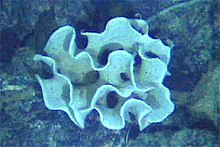Xenophyophore
| Xenophyophores | |
|---|---|
 |
|
| Xenophyophore in the Galapagos Rift | |
| Scientific classification | |
| Domain: | Eukaryota |
| (unranked): | SAR |
| (unranked): | Rhizaria |
| Phylum: | Retaria |
| Subphylum: | Foraminifera |
| Class: | Xenophyophorea |
| Orders | |
Xenophyophores are giant multinucleate single celled organisms found on the ocean floor throughout the world's oceans, at depths of 500 to 10,600 meters (6.6 miles). They are a kind of foraminifera that extract minerals from their surroundings and use them to form an exoskeleton known as a test.
They were first described by Henry Bowman Brady in 1883. They are abundant on abyssal plains, and in some regions are the dominant species. Fourteen genera and approximately 60 species have been described, varying widely in size. The largest, Syringammina fragilissima, is among the largest known coenocytes, reaching up to 20 centimetres (7.9 in) in diameter.
Xenophyophores are an important component of the deep sea-floor, as they have been found in all four major ocean basins. However, so far little is known about their biology and ecological role in deep-sea ecosystems.
They form delicate and elaborate agglutinated tests that range from a few millimetres to 20 centimetres. Species of this group are morphologically variable, but the general structural pattern includes a test enclosing a branching system of organic tubules together with masses of waste material (stercomata). The softness and structure of tests varies from soft and lumpy shapes to fans and complex structures.
Xenophyophores are often found in areas of enhanced organic carbon flux, such as beneath productive surface waters, in sub-marine canyons, in settings with sloped topography (e.g. seamounts, abyssal hills) and on continental slopes. They select certain minerals and elements from their environment that are included in its tests and cytoplasm, or concentrated in excretions. The selected minerals vary with species, but often include barite, lead and uranium.
Their name Xenophyophora means "bearer of foreign bodies", from the Greek. This refers to the sediments, called xenophyae, which are cemented together to construct their tests. In 1883, Henry Bowman Brady classified them as primitive Foraminifera. Later they were placed within the sponges. In the beginning of the 20th century they were considered an independent class of Rhizopoda, and later as a new eukaryotic phylum of Protista. As of 2015, recent phylogenetic studies suggest that xenophyophores are a specialized group of monothalamous (single-chambered) Foraminifera.
...
Wikipedia
